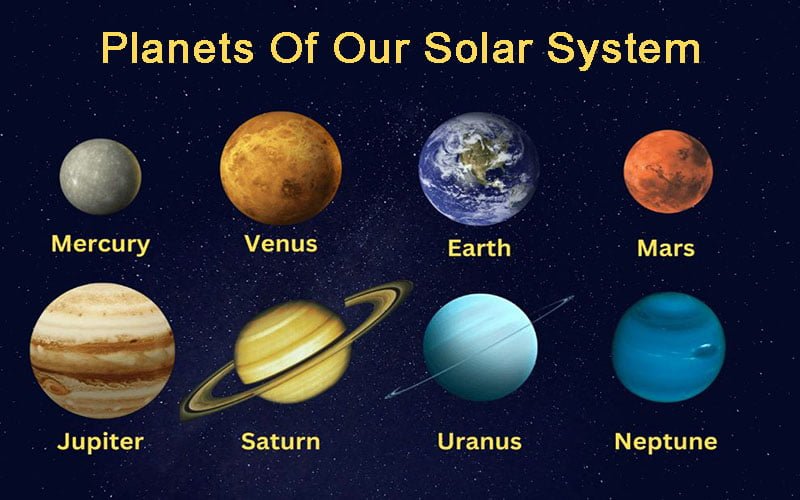
Have you ever wondered how many planets are there in our vast and mysterious universe? Well, you’re not alone! Humans have been captivated by the wonders of outer space for centuries, and the question of how many planets exist has always intrigued us. Here, we know more about our own solar system and explore the answer to the question “how many planets are there?”. Get ready to embark on a cosmic journey as we uncover the secrets of our celestial neighborhood.
Let’s start by addressing the central question: how many planets are there in our solar system? As of our current understanding, there are officially eight planets in our solar system. These planets, in order of their distance from the Sun, are Mercury, Venus, Earth, Mars, Jupiter, Saturn, Uranus, and Neptune. Each of these planets has its own unique characteristics and features that make them fascinating subjects of study for astronomers and space enthusiasts alike.
Mercury, named after the Roman god of commerce, is the closest planet to the Sun. It is a small, rocky planet with a thin atmosphere. Due to its proximity to the Sun, Mercury experiences extreme temperature variations, ranging from scorching hot to freezing cold. Despite its harsh conditions, Mercury is a subject of great interest for scientists, who study its geological features and composition to gain insights into the formation and evolution of our solar system.
Often referred to as Earth’s sister planet, Venus is the second planet from the Sun. It is named after the Roman goddess of love and beauty, which is fitting considering its dazzling appearance in the night sky. Venus is also known for its thick atmosphere, composed mainly of carbon dioxide, which creates a runaway greenhouse effect and leads to a scorching hot surface temperature. Studying Venus helps us better understand the potential effects of climate change and the importance of preserving Earth’s delicate balance.
Ah, our home planet, Earth. As the third planet from the Sun, Earth holds a special place in our hearts. It is the only known celestial body to support life, boasting a diverse range of ecosystems and a delicate balance of elements that allow for the existence of complex organisms. From lush rainforests to vast oceans, Earth is a testament to the wonders of our natural world. As we continue to explore the cosmos, understanding our own planet becomes crucial in ensuring its preservation and the search for life beyond our solar system.
Known as the Red Planet, Mars has captivated human imagination for centuries. It is the fourth planet from the Sun and derives its reddish hue from iron oxide, commonly known as rust, present on its surface. Mars has long been a subject of interest for scientists searching for signs of past or present life. As we send rovers and landers to explore its terrain, we gather valuable data that may one day help us answer the age-old question of whether life exists beyond Earth.
As we move farther from the Sun, we encounter Jupiter, the largest planet in our solar system. Jupiter’s immense size and powerful magnetic field make it a truly remarkable celestial body. This gas giant is composed mostly of hydrogen and helium and is known for its iconic feature: the Great Red Spot, a gigantic storm system larger than Earth. Studying Jupiter provides valuable insights into the dynamics of gas giants and the formation of planetary systems.
Saturn, often referred to as the jewel of our solar system, is famous for its magnificent rings. These rings, composed of countless particles of ice and rock, encircle the planet and create a mesmerizing sight when observed from space. Saturn’s rings are a subject of ongoing study, as scientists strive to understand their origin and evolution. With its unique beauty and intricate dynamics, Saturn continues to captivate our imagination.
Moving further into our solar system, we encounter Uranus, the seventh planet from the Sun. Uranus is an ice giant, composed mainly of hydrogen, helium, and methane. It is unique among the planets in our solar system due to its extreme axial tilt, causing it to appear to roll on its side as it orbits the Sun. This peculiar characteristic has puzzled scientists for centuries, and studying Uranus provides valuable insights into the formation and dynamics of planetary systems.
Finally, we reach Neptune, the eighth and farthest planet from the Sun. Neptune is another ice giant, similar in composition to Uranus. It is known for its striking blue color, which is attributed to the presence of methane in its atmosphere. As we continue to explore Neptune, we gain a better understanding of the diverse range of planetary environments and the incredible beauty that exists in the depths of our solar system.
The number of planets in our solar system was determined by the International Astronomical Union (IAU) in 2006. According to their definition, a planet is a celestial body that orbits the Sun, is spherical in shape, and has cleared its orbit of any debris. Based on these criteria, Pluto, previously considered the ninth planet, was reclassified as a dwarf planet, reducing the total number of planets to eight.
While the eight known planets in our solar system have been extensively studied, there is ongoing research to uncover potential additional celestial bodies. Astronomers are actively searching for distant objects beyond the orbit of Neptune, often referred to as the Kuiper Belt, that may be classified as planets or dwarf planets. The discovery of new objects could potentially expand our understanding of our cosmic neighborhood.
As of now, no definitive evidence of extraterrestrial life has been found on any of the planets in our solar system. However, scientists continue to explore environments that could potentially harbor microbial life, such as Mars and the icy moons of Jupiter and Saturn. The search for life beyond Earth remains one of the most fascinating and challenging quests in the field of astronomy.
The prospect of humans living on other planets has been a subject of scientific and technological exploration. While certain planets, such as Mars, have been identified as potential candidates for future human colonization, the challenges and complexities involved are immense. Factors such as the harsh environment, lack of breathable atmosphere, and limited resources pose significant obstacles to sustained human habitation. However, ongoing research and technological advancements continue to push the boundaries of space exploration.
Yes, there are countless planets outside our solar system, known as exoplanets. These distant worlds orbit stars other than our Sun and come in a variety of sizes and compositions. The discovery of exoplanets has revolutionized our understanding of the universe. Also opened up new possibilities for finding habitable environments and even potential life beyond our solar system.
Astronomers employ various methods to discover planets. One common technique is the transit method, where scientists observe a star for regular dimming caused by a planet passing in front of it. Another method is the radial velocity method, which detects small wobbles in a star’s motion caused by the gravitational pull of an orbiting planet. Additionally, advanced instruments and telescopes, such as the Kepler and TESS missions, have greatly contributed to the discovery of exoplanets.
In conclusion, our solar system consists of eight planets: Mercury, Venus, Earth, Mars, Jupiter, Saturn, Uranus, and Neptune. Each planet offers unique characteristics and scientific insights that continue to fascinate researchers and space enthusiasts. As we gaze at the night sky and ponder the question “how many planets are there”. Let us marvel at the vastness and beauty of our cosmic neighborhood. The exploration of our solar system and beyond remains an ongoing endeavor, driving us to unravel the mysteries of the universe.
Recommended other topics: Facts About Black Holes










© InfoDoot. All Rights Reserved.